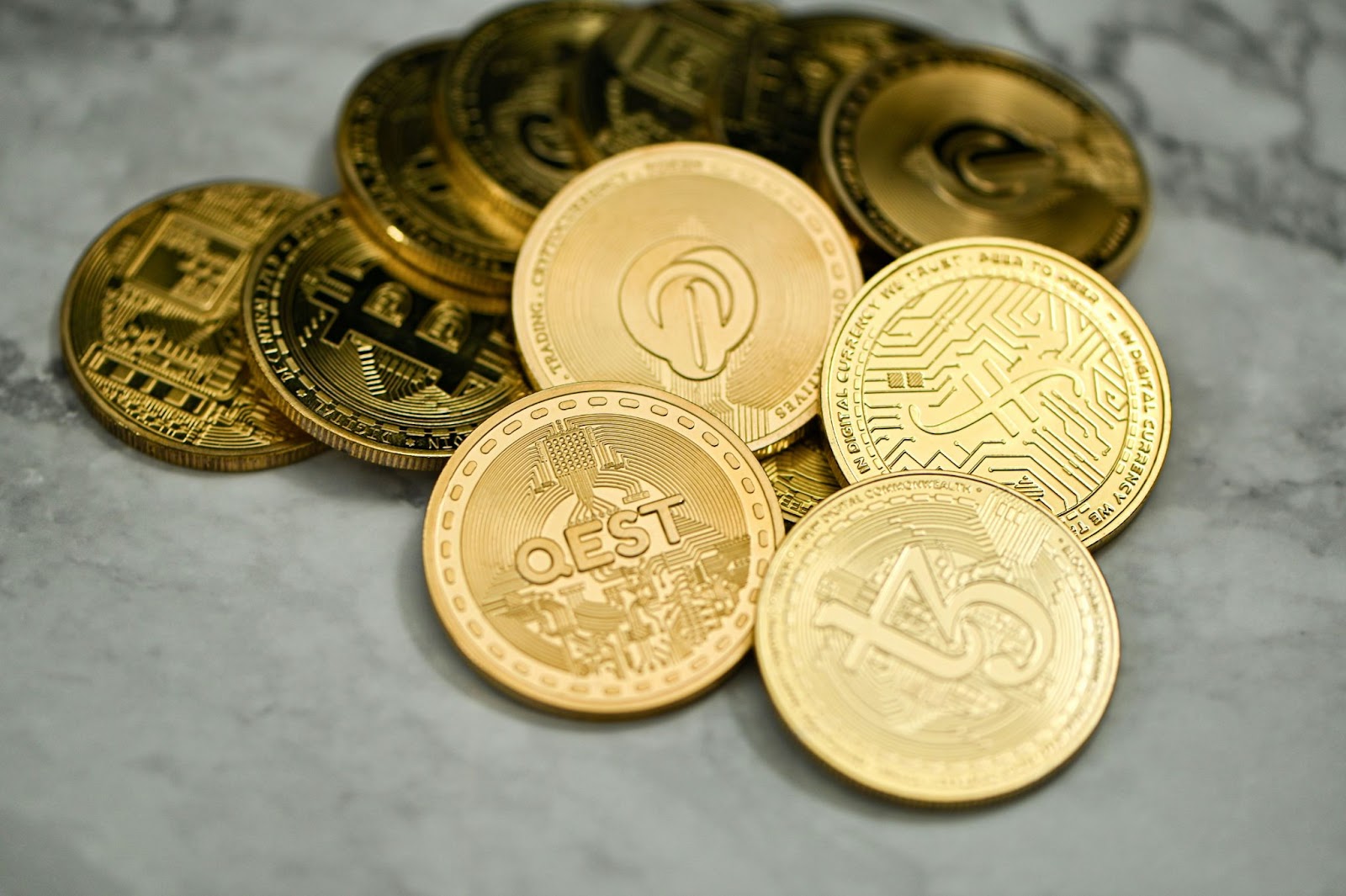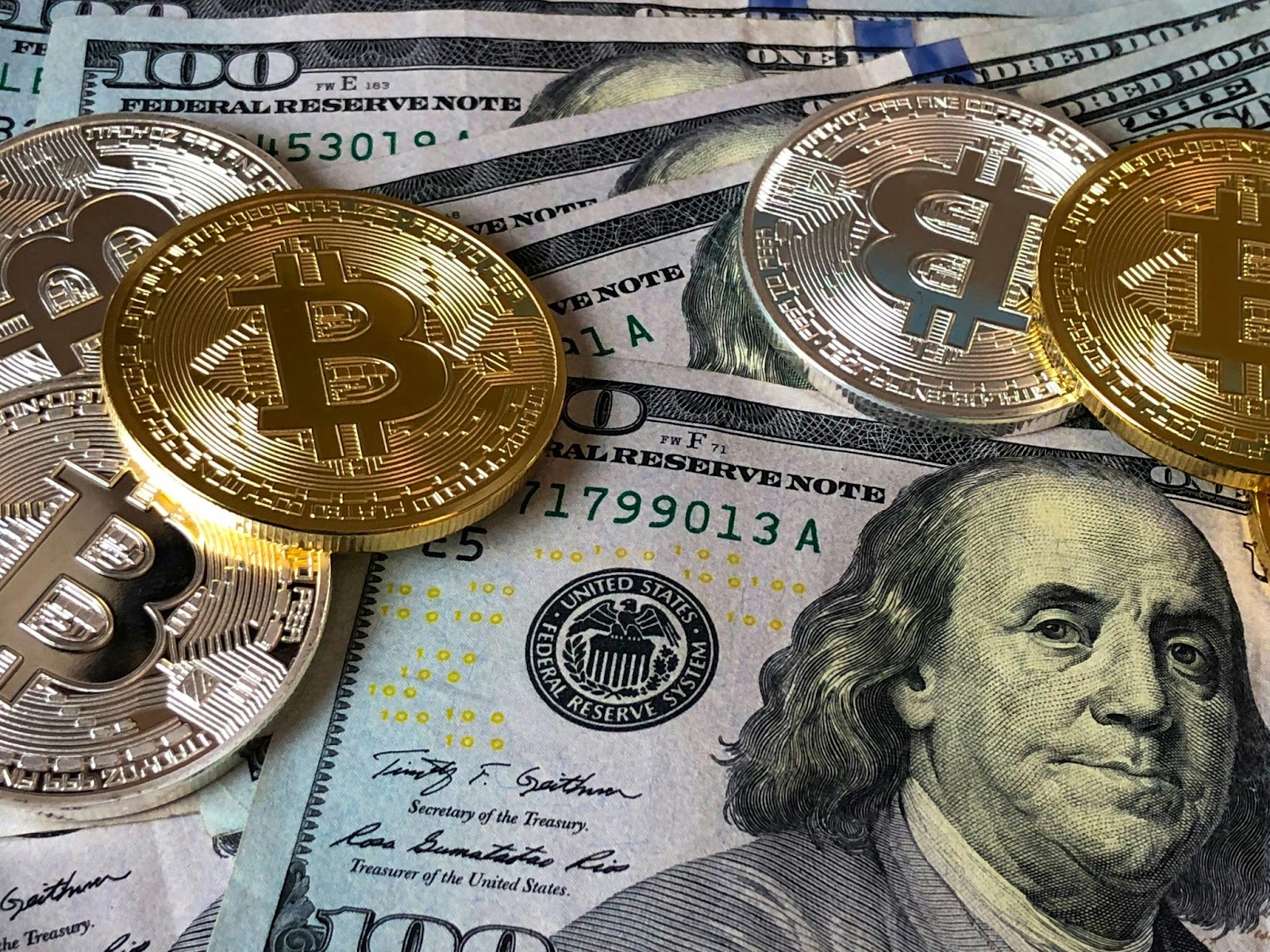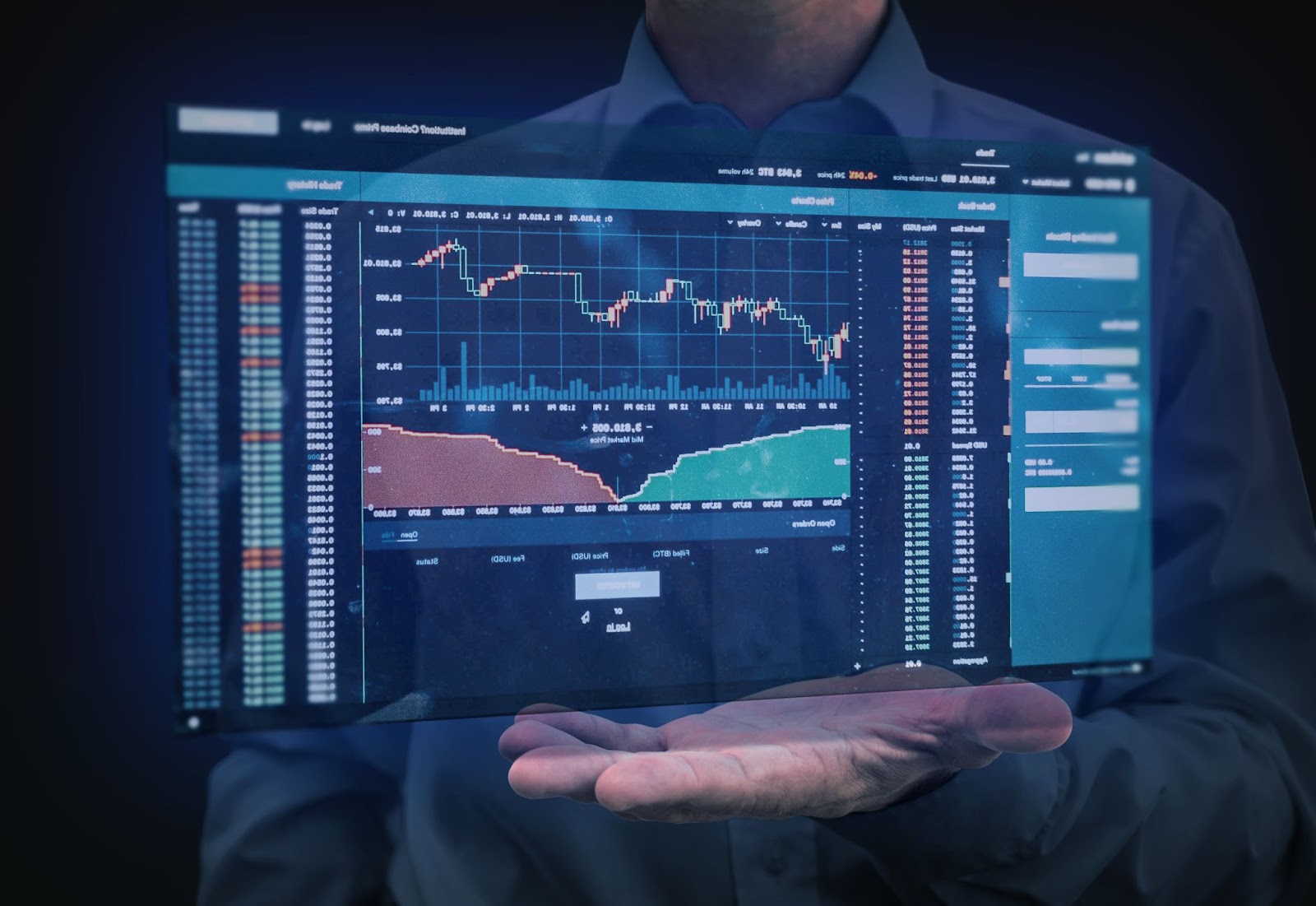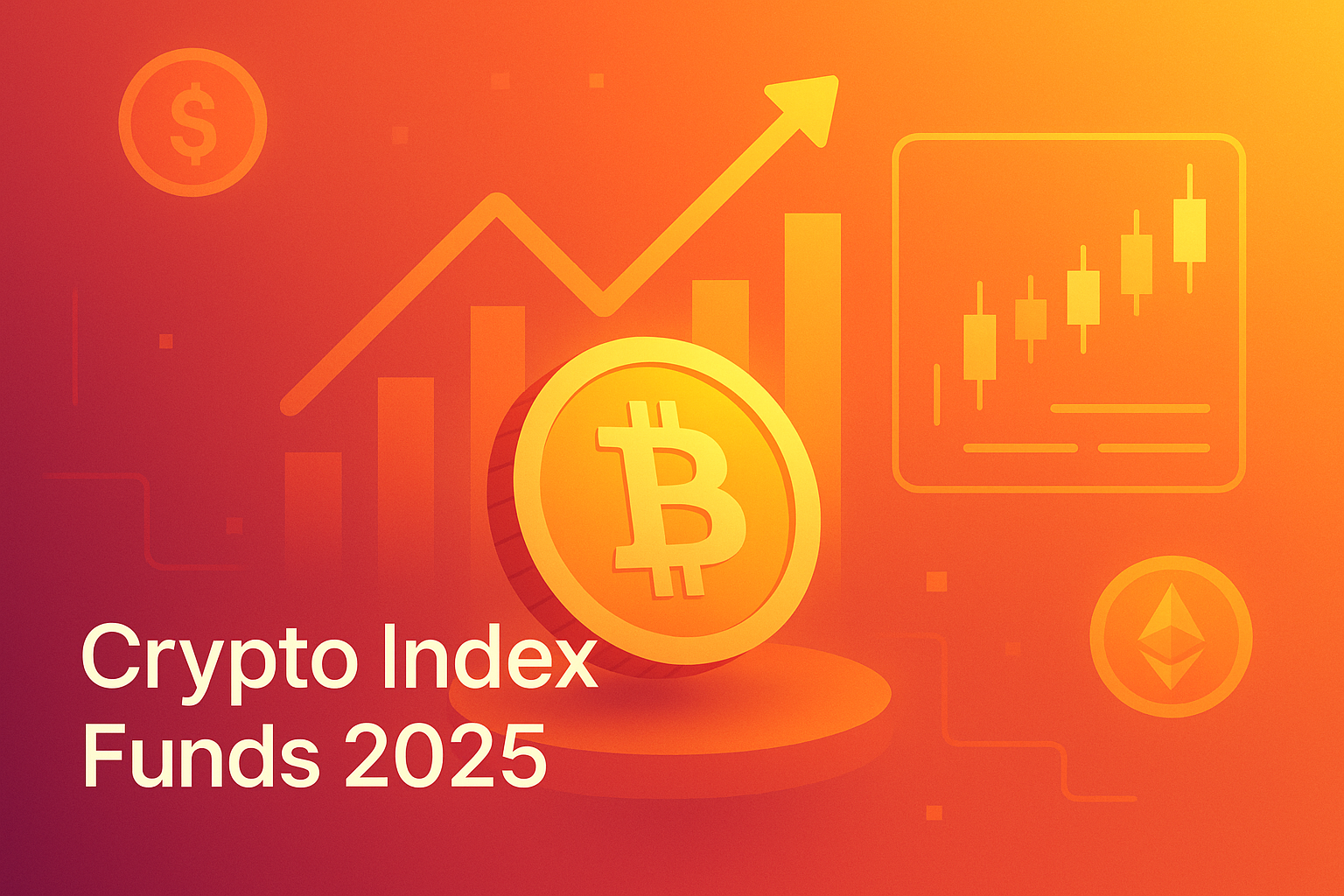Find out everything you need to know about crypto index funds 2025.
Imagine trying to bet on the future of crypto without having to pick a single winning coin. Sounds good, right? That’s exactly what crypto index funds 2025 are all about.
New tokens emerge almost every day in the crypto market. Prices swing wildly. And the market sentiment? As volatile as it can be. Thus, investment might feel like nothing but a risky gamble. Yet, in such a turbulent space, crypto index funds offer a safer, more balanced way to invest. These top performing crypto ETFs provide exposure to a variety of digital assets without forcing you to play favorites.
So, what exactly are these funds? How do they work and why are investors turning to them? Let’s paint the full picture.
Passive Crypto Investing and the Rise of Crypto Index Funds 2025

Illustration of a person earning passively.
Credits: Image on Freepik
Cryptocurrency investing has come a long way since the early days of Bitcoin. What started as a niche technology experiment has now evolved into a multi-trillion-dollar asset class. It has now got thousands of digital tokens, platforms, innovations, and communities like Investors Collective.
However, with rapid growth comes complexity. Today, for many investors, navigating the crypto landscape feels overwhelming.
That’s why many are turning to passive crypto investing. It is a smarter, simpler way to participate in this digital revolution. All without the stress of daily trading or speculative coin-picking.
Understanding Passive Crypto Investing
Before diving into crypto index funds, let’s first explore what passive investing means in the context of cryptocurrency.
In traditional finance, passive investing involves buying into diversified portfolios (like index funds or ETFs) that track an entire market or sector. You don’t try to beat the market. You ride the wave. It’s cost-effective, low-maintenance, and ideal for long-term growth.
Passive crypto investing follows the same philosophy. Instead of trading individual coins or timing market cycles, passive investors aim to:
- Gain broad market exposure
- Reduce volatility and risk
- Hold assets long-term
- Avoid emotional decision-making
Passive crypto investing appeals to those who believe in the long-term growth of blockchain technology. Yet, they want to avoid the chaos and noise of daily crypto markets.
For such a setup, two investment vehicles have turned out to be the most popular. Crypto index funds and blockchain ETFs. Some people use these terms interchangeably. However, there’s a difference between them. Let’s explore it.
What Is a Blockchain ETF?
A blockchain ETF is a fund that invests in:
- Companies building blockchain technology (like Coinbase, Riot, or NVIDIA)
- Crypto asset infrastructure
They offer exposure to the blockchain sector without directly holding any cryptocurrencies. These ETFs are regulated and available on traditional brokerages, making them accessible to conservative or institutional investors. And that’s what makes them different from crypto index funds, our main topic today.
So, let’s explore crypto index funds 2025 in detail.
What Is a Crypto Index Fund?

A crypto index fund spreads investment across multiple coins.
Credits: Photo by Traxer on Unsplash
A crypto index fund is an investment vehicle that tracks the performance of a basket of tokens.
What that means is you’re not investing in a single coin. You’re also not making multiple investments across different coins. Rather you put your money into a fund, through a single investment, that includes multiple coins.
These coins are selected based on market cap, liquidity, or a specific strategy.. This method offers diversification, helps reduce risk, and smooths out the wild swings that crypto markets are famous for. In short:
A crypto index fund allows you to invest in the entire crypto market (or a segment of it) through one single investment.
What Is a Basket of Tokens?
A crypto index fund is a type of passive investment vehicle that tracks a group, or “basket”, of cryptocurrencies. Think of it like the S&P 500 of crypto. But instead of holding stocks, it holds digital tokens.
A basket of tokens is a collection of different cryptocurrencies bundled together. Your money is spread across several assets. This could include:
- Large-cap coins (BTC, ETH)
- Mid-cap altcoins (Solana, Avalanche)
- Sector-specific tokens (DeFi, NFT, Metaverse)
- Emerging projects
The basket can be market cap-weighted, equally weighted, or thematically structured.
How Do Crypto Index Funds Work?
Let’s say you invest in a crypto index fund that tracks the top 10 cryptocurrencies by market cap. That fund will automatically allocate your money across those 10 coins. Typically in proportion to their size.
So if Bitcoin makes up 45% of the total crypto market cap, 45% of your investment goes into BTC. If Ethereum is 20%, then 20% goes to ETH. And so on. However, the investment is fixed. The fund rebalances regularly (monthly or quarterly).
So as market values shift, the holdings get adjusted. Here’s how it works step-by-step:
- Selection of Assets: The index fund sets rules for what goes in (e.g., top 10 coins by market cap).
- Allocation: Money is spread across the selected assets, usually in weighted proportions.
- Rebalancing: Over time, the values of the coins change. The fund periodically adjusts allocations to stay true to its index.
- Performance Tracking: The fund’s value rises or falls based on the collective performance of its coins.
How Rebalancing Works in Crypto Index Funds
Rebalancing is the magic that keeps an index fund aligned with its investment strategy. It happens in three main steps:
- Valuation Check: The fund reviews the current prices of each asset.
- Weight Comparison: It compares current weights to the target allocations.
- Buy/Sell to Rebalance: Assets that are overweight are trimmed; underweight assets are topped up.
This process ensures that the fund doesn’t become overly dependent on one token that suddenly surges or drops.
Key Features of Crypto Index Funds
Here are the main features of a crypto index fund.
1. Diversification
Diversification is the most important benefit. By spreading your investment across multiple assets, you reduce the risk of any single coin tanking your portfolio.
2. Passive Investment
You don’t have to constantly monitor the market or make trading decisions. The fund does all the rebalancing for you.
3. Market Exposure
Index funds give you broad exposure to the crypto market. You ride the wave of the entire ecosystem instead of betting on individual winners.
4. Cost-Efficiency
Fees are often lower than active crypto management services because index funds follow pre-set rules rather than trying to beat the market.
5. Transparency
Most index funds publish their methodology and current holdings. You know exactly what you’re investing in.
Overall, a crypto index fund is simply a basket of tokens you invest in. Where your investment isn’t limited to one coin. Rather it is spread across all the tokens in the basket. With that explored, let’s explore different types of crypto index funds.
Types of Crypto Index Funds 2025
Credits: AI Generated Image
There isn’t just one kind of crypto index fund. Different funds serve different investment goals:
1. Market Cap Weighted Funds
These funds track coins based on their market capitalization. For example, a fund may include the top 10 or top 20 cryptocurrencies.
2. Equal Weighted Funds
Here, all cryptocurrencies in the index receive equal allocation. Regardless of their size. This avoids heavy reliance on BTC or ETH.
3. Sector-Specific Funds
Some funds focus on a particular category of crypto assets, like DeFi, Web3, or metaverse tokens. For example, an index fund that includes only DeFi tokens like Uniswap, Aave, Compound, etc.
4. Thematic Funds
These track emerging trends in crypto. For example, an index fund may focus on “green” cryptocurrencies that use proof-of-stake or eco-friendly technologies.
So, these are the four main types of crypto index funds. Each has its own pros and cons. As an investor, you can make investments across different funds. If not, choose the one which suits your risk tolerance and goals.
Benefits of Investing in Crypto Index Funds 2025

Crypto index funds 2025 can offer lucrative returns, if done right.
Credits: Photo by David McBee
You might be wondering: Why invest in a crypto index fund to begin with? Can’t you just spread your investment across multiple coins without involving a fund? Well, it has plenty of other benefits besides the diversity.
1. Lower Risk, Higher Exposure
By not putting all your eggs in one basket, you gain more stable returns while still participating in crypto’s upside.
2. Time-Saving
No need to research each new altcoin or manage your portfolio daily. The fund managers do that for you. Plus, they have more experts and tools at their disposal.
3. Ideal for Beginners
New to crypto? Index funds let you get started without deep technical knowledge.
4. Long-Term Potential
If you believe in the future of blockchain, an index fund helps you benefit from the ecosystem’s growth. Not just one coin’s success.
So, Should You Invest in Crypto Index Funds?
Crypto index funds aren’t a get-rich-quick tool. But they can be a smart long-term strategy if you:
- Want to invest in crypto without constant trading.
- Believe in the future of blockchain.
- Prefer a low-maintenance, passive approach.
- Value diversification and reduced risk.
That said, always invest what you can afford to lose. The crypto world is exciting. But it’s still maturing.
All in all, these benefits make a crypto index fund much more lucrative than making multiple investments across different coins yourself. That said, how do you invest in a crypto index fund?
How to Invest in a Crypto Index Fund
Credits: AI Generated Image
You can invest in crypto index funds in several ways:
1. Via Crypto Platforms
Some platforms offer index fund products directly. Examples include:
- Bitwise
- Grayscale (though more like trusts)
- Crypto20
- Indexed Finance (for decentralized exposure)
2. Through DeFi Protocols
Platforms like TokenSets or Indexed Finance let you invest in tokenized index products using a crypto wallet.
3. ETFs (Where Available)
In some jurisdictions, regulated crypto ETFs (Exchange-Traded Funds) are available. These mimic index fund behavior but trade on stock exchanges.
Note: As of 2025, full crypto ETFs are approved in some countries like the U.S., Canada, and Germany, but not globally.
With that covered, let’s explore the top crypto index funds 2025.
The Top 10 Crypto Index Funds 2025

A holographic screen showing top crypto index funds 2025.
Credits: Image on Freepik
In 2025, several well-designed crypto index funds have risen in popularity. Offering different approaches. From top coins to DeFi, Web3, and even eco-friendly tokens. Let’s explore the top 10 crypto index funds 2025, why they matter, what makes each one unique, and how they fit into your investment strategy.
1. Bitwise 10 Crypto Index Fund (BITW)
Type: Market Cap Weighted
Exposure: Top 10 Cryptocurrencies
Structure: Managed Fund (U.S. based)
Overview:
Bitwise’s flagship product remains one of the most trusted and widely followed crypto index funds. It gives investors exposure to the top 10 largest cryptocurrencies by market cap, including Bitcoin, Ethereum, Solana, and Avalanche.
Why it’s top-tier:
- Rebalanced monthly
- Backed by institutional-grade custody
- Offers shares to retail and accredited investors
Perfect for: Investors seeking broad, large-cap exposure in a professionally managed format.
2. CoinDesk Market Index (CMI)
Type: Broad Market Index
Exposure: 90%+ of Total Crypto Market Cap
Structure: Benchmark-style index
Overview:
CoinDesk’s CMI tracks nearly 100 assets, making it one of the most comprehensive market-wide indexes in crypto. While not an investable fund itself, many products and ETFs are built to mimic its structure.
Why it’s top-tier:
- Ideal for benchmark tracking
- Transparent, rules-based inclusion
- Used by institutions
Perfect for: Long-term investors who want to mirror the entire crypto ecosystem.
3. Crypto20 (C20)
Type: Tokenized Index Fund
Exposure: Top 20 Cryptocurrencies
Structure: Smart Contract Managed (DeFi)
Overview:
Crypto20 is one of the first decentralized crypto index funds. Fully tokenized via the C20 token, it includes 20 leading cryptocurrencies and runs autonomously on smart contracts.
Why it’s top-tier:
- Transparent & decentralized
- Low fees, no middlemen
- Self-custodied via crypto wallets
Perfect for: Crypto-savvy users who prefer non-custodial, DeFi-native investments.
4. DeFi Pulse Index (DPI)
Type: Sector-Specific Index
Exposure: DeFi Tokens
Structure: Tokenized Index (Ethereum-based)
Overview:
Launched by Index Coop, DPI is a community-favorite that tracks the most successful decentralized finance tokens like Uniswap, Aave, Compound, and others.
Why it’s top-tier:
- Strong performance during DeFi bull cycles
- Rebalanced monthly
- Fully decentralized
Perfect for: Investors who believe DeFi is the future of finance.
5. Galaxy Crypto Index Fund
Type: Market Cap Weighted
Exposure: Large-Cap Digital Assets
Structure: Private Fund
Overview:
Offered by Galaxy Digital, this fund is designed for institutional clients. It targets top-performing, high-liquidity crypto assets, with a heavy focus on BTC and ETH, while incorporating other blue-chip tokens.
Why it’s top-tier:
- Professional-grade investment strategy
- Backed by Mike Novogratz’s Galaxy Digital
- Appeals to hedge funds and family offices
Perfect for: High-net-worth individuals or institutional players seeking risk-managed exposure.
6. Index Coop’s Metaverse Index (MVI)
Type: Thematic Index
Exposure: Metaverse and NFT-Related Tokens
Structure: Tokenized Index Fund
Overview:
If you’re bullish on the intersection of crypto and digital culture, MVI is a go-to. It tracks projects like Decentraland, The Sandbox, Axie Infinity, and other metaverse-native tokens.
Why it’s top-tier:
- Targets a fast-growing niche
- Fully on-chain and transparent
- Backed by DAO governance
Perfect for: Gamers, creators, and metaverse believers.
7. TokenSets’ Top Crypto Index (TCI)
Type: DeFi Index
Exposure: Top-performing Assets by Momentum
Structure: Algorithmic Strategy via Smart Contracts
Overview:
TCI is a smart DeFi index that automatically rotates holdings based on price momentum and technical signals. It adjusts between top assets based on real-time metrics.
Why it’s top-tier:
- Autonomous rebalancing
- Actively optimized via smart contracts
- Minimal human involvement
Perfect for: Tech-savvy investors who want hands-free, rule-based investing.
8. Grayscale Digital Large Cap Fund (GDLC)
Type: Trust Structure
Exposure: BTC, ETH, SOL, ADA, MATIC, and others
Structure: SEC-reporting fund
Overview:
Grayscale’s fund includes multiple large-cap crypto assets, offering exposure through a regulated structure. It trades like a security and is popular among U.S. investors.
Why it’s top-tier:
- Strong legal compliance
- Professional custodianship
- Recognized by traditional markets
Perfect for: U.S. investors who want crypto exposure through stock-like instruments.
9. Hashdex Nasdaq Crypto Index ETF
Type: Exchange-Traded Fund
Exposure: Top Nasdaq-selected Crypto Assets
Structure: Public ETF (available in Brazil and global markets)
Overview:
One of the first globally accessible crypto ETFs, this fund tracks a Nasdaq-vetted crypto index. It brings institutional credibility to the table with the flexibility of ETF trading.
Why it’s top-tier:
- Real-time trading
- Fully regulated
- Co-designed with Nasdaq
Perfect for: Traditional investors seeking ETF-style exposure to crypto.
10. IC15 Index Fund by CryptoWire
Type: Market-Cap Weighted
Exposure: India’s Top 15 Crypto Assets
Structure: Digital Index (reference benchmark)
Overview:
IC15 is a unique regional index focusing on India’s top crypto assets. While it began as a reference index, tokenized investment vehicles are now emerging based on it.
Why it’s top-tier:
- Reflects growing Indian crypto market
- Offers geographical diversification
- Used by new Indian crypto ETFs and apps
Perfect for: Investors wanting emerging market crypto exposure.
Which Crypto Index Fund Is Right for You?
Choosing the right crypto index fund depends on your risk appetite, belief in the market, and investment strategy. Here’s a quick recap based on goals:
| Goal | Best Fund |
| Broad Market Exposure | Bitwise 10, CoinDesk CMI |
| DeFi Exposure | DeFi Pulse Index |
| Metaverse Focus | MVI |
| Institutional Strategy | Galaxy Crypto Index, GDLC |
| Decentralized Investing | Crypto20, TokenSets |
| ETF Access | Hashdex Nasdaq ETF |
| Regional Exposure | IC15 Index |
As of 2025, crypto index funds have matured. They now serve both retail and institutional investors, offering exposure to the hottest sectors, from DeFi to the metaverse, without the headache of day trading or market timing.
Whether you’re a cautious beginner or a seasoned investor, these top 10 crypto index funds offer a safer, smarter way to participate in the blockchain revolution.
The Risks and Limitations of Crypto Index Funds 2025

Crypto index funds 2025 are profitable, but not without risks.
Credits: Image on Freepik
Crypto index funds have become one of the most popular ways to invest in digital assets. They promise diversification, simplicity, and exposure to the fast-growing world of cryptocurrencies. All in one basket.
For many, they represent the perfect passive investing tool for navigating the chaos of the crypto market. But here’s the truth: crypto index funds are not risk-free.
Just like any other investment, they come with their own set of drawbacks, risks, and limitations. And if you’re considering putting your money into one, it’s crucial to understand the full picture.
1. Market Volatility Still Exists
Crypto is known for its extreme price swings, and investing in an index fund doesn’t shield you from that volatility. While diversification may reduce the risk tied to a single asset (like Bitcoin or Ethereum), your overall portfolio can still take a big hit during a market crash.
For example, if the top 10 cryptocurrencies lose 50% of their value in a bear market, a fund tracking them will drop just as hard. Even a well-diversified crypto index fund can experience sharp drawdowns of 30–70% in a short time.
Bottom line: Diversification softens the blow. But it doesn’t eliminate the rollercoaster ride that defines the crypto market.
2. Overexposure to Bitcoin and Ethereum
Most crypto index funds are market-cap weighted, which means they assign a higher percentage of your investment to the biggest cryptocurrencies. In nearly all cases, that means Bitcoin and Ethereum dominate the portfolio.
In fact, it’s not uncommon for over 70% of a fund’s value to be tied up in just these two coins. While BTC and ETH are relatively stable (compared to altcoins), this can lead to:
- Lack of true diversification
- Missing out on gains from emerging projects
- A fund that feels more like a Bitcoin-heavy ETF
Takeaway: If you want broader exposure to the innovation happening beyond the two giants, many index funds may fall short.
3. Custodial and Counterparty Risks
Some crypto index funds, especially those offered through traditional finance platforms, require you to give up control of your crypto. The fund holds your assets on your behalf. Sometimes through a third-party custodian. This creates custodial risk:
- If the fund or custodian is hacked, your assets could be lost.
- If the company goes bankrupt or is frozen by regulators, withdrawals may be halted.
- In DeFi index funds, smart contract vulnerabilities may lead to asset loss.
Lesson: When you don’t hold the private keys, you’re relying on the trustworthiness and security practices of someone else.
4. Rebalancing Risks and Delays
Index funds typically rebalance periodically to reflect updated asset weights or replace underperforming tokens. While this process is essential, it comes with some risks:
- Slippage: Fast-moving markets can lead to bad trade execution.
- Delays: Rebalancing may happen weekly or monthly, meaning the fund may lag behind market trends.
- Forced Sales: Projects that temporarily underperform or lose liquidity may be sold off at a loss.
Also, unexpected rebalances might trigger taxable events depending on your jurisdiction.
5. Hidden Fees and Expense Ratios
Crypto index funds often promise lower fees than active funds. But fees still exist. And in some cases, they may be hidden or higher than expected, especially if:
- The fund is actively managed behind the scenes.
- There are performance fees, custody fees, or smart contract fees.
- You’re buying index tokens through DeFi platforms with high gas costs.
Additionally, many publicly traded crypto funds (like Grayscale or Bitwise) trade at premium or discount prices compared to their net asset value (NAV), which can affect your true return.
6. Lack of Regulation and Investor Protection
In traditional finance, index funds are heavily regulated, ensuring transparency and investor protection. But in crypto?
Not so much.
Many crypto index funds operate in grey areas, especially those based on DeFi or issued offshore. Risks include:
- Limited legal recourse in the event of fraud or mismanagement.
- No FDIC or government backing if the fund fails.
- Unclear asset custody rules, especially in decentralized structures.
For retail investors, this lack of regulation can translate into unexpected surprises. And not the good kind.
7. Limited Availability and Accessibility
Not all crypto index funds are open to everyone.
- Some are restricted to accredited or institutional investors.
- Others are only accessible in certain countries due to regulatory constraints.
- DeFi-based funds often require self-custody and knowledge of Web3 wallets.
Also, many crypto index funds aren’t available on regular stock trading platforms, making them less accessible than traditional ETFs. This can be frustrating for investors who want a simple “set it and forget it” solution.
8. Illiquidity in Smaller Holdings
If an index fund includes low-cap altcoins, there’s a risk that some tokens may be:
- Hard to trade
- Poorly priced
- Extremely volatile
During a bear market or black swan event, these assets may lose value quickly or become untradeable, dragging down the entire fund. This is especially true for funds that stretch beyond the top 20 coins or include experimental sectors like NFTs or GameFi.
9. One-Size-Fits-All Approach
Crypto index funds follow fixed rules. While this removes emotion from investing, it also limits your ability to:
- React to news or major events
- Avoid coins you personally don’t believe in
- Capitalize on new trends (since rebalancing is slow)
For example, a meme coin may enter the top 10 due to hype and get added to the index. Even if its fundamentals are weak. Likewise, promising but small projects won’t be included due to low market cap.
In short, you lose control over asset selection.
10. Lagging Performance in Bull Runs
Surprisingly, during aggressive bull markets, crypto index funds can underperform individual coins or even simple BTC/ETH portfolios. Why?
- Gains from moonshot coins are averaged out by underperformers.
- Rebalancing may dilute winning positions.
- Top-weighted coins may grow slowly compared to low-cap alts.
If your goal is maximum growth, actively picking winners (though riskier) often beats passive indexing.
In a Nutshell
Crypto index funds offer a compelling solution for investors looking to simplify their entry into the digital asset space. They reduce the need for daily decision-making, provide exposure to multiple assets, and help spread out risk.
However, they are not magic bullets. Thus, before investing, you must consider:
- The underlying assets and how they’re weighted
- The platform or custodian managing the fund
- Associated fees and rebalancing frequency
- Your own risk tolerance and investment goals
Crypto is still young. And while index funds can smooth out some of the bumps, the ride is far from smooth.
Final Thoughts
Crypto index funds 2025 offer one of the simplest, smartest, and most stress-free ways to invest in digital assets. Whether you’re a beginner looking for passive exposure or a seasoned investor aiming for a balanced portfolio, index funds can be a powerful tool.
They strip away the noise, reduce the guesswork, and allow you to ride the wave of the entire crypto revolution. Without betting on any single coin.
All in all, if you want crypto exposure without the chaos, crypto index funds 2025 might be the perfect fit.
Frequently Asked Questions (FAQ)
1. Can I earn passive income from crypto index funds?
Some tokenized index funds offer staking or yield farming features, but most traditional index funds focus solely on price appreciation, not income generation.
2. Are there tax implications when investing in crypto index funds?
Yes, depending on your country, buying, selling, or rebalancing index tokens may trigger capital gains taxes, especially if done frequently or automatically.
3. Can I create my own custom crypto basket?
Yes, platforms like TokenSets or Rebalance.fi allow users to create personalized crypto baskets and automate strategies using smart contracts.
4. How are new coins added to crypto index funds?
Most funds follow a rules-based system, adding new tokens based on criteria like market cap, liquidity, or project longevity during periodic rebalancing.
5. Do blockchain ETFs hold actual cryptocurrencies?
Most blockchain ETFs hold shares of companies involved in crypto or blockchain, not cryptocurrencies themselves. Though some now offer Bitcoin or Ethereum exposure.
6. Are crypto index funds safe from rug pulls or scams?
While large, reputable funds are relatively secure, some smaller or decentralized index products may include risky or unaudited tokens, so due diligence is essential.

